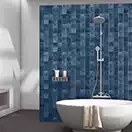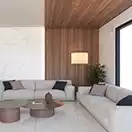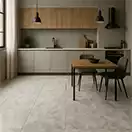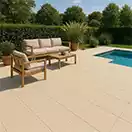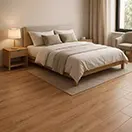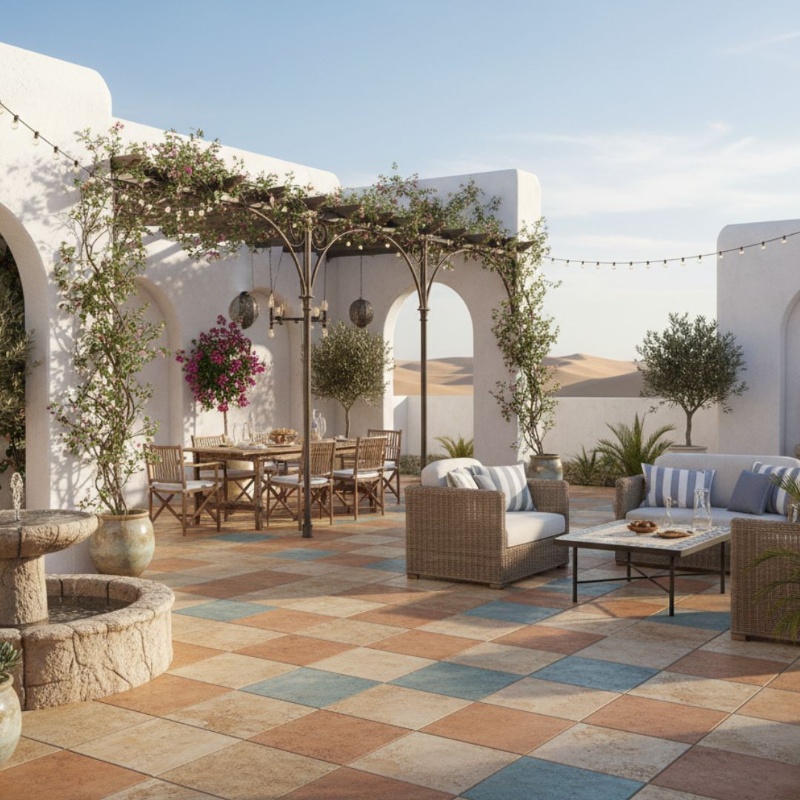A Practical Guide to Choosing Desert-Inspired Outdoor Tiles
Outdoor areas in Dubai are increasingly being designed as usable living spaces, patios for family gatherings, pool decks for warm evenings, and rooftop terraces for private relaxation. The flooring used in these spaces has a direct impact on comfort, durability, and design appeal. Choosing the right desert-inspired outdoor tiles means selecting materials that not only look good but also withstand local climate conditions.
This guide explains the factors to consider, supported by real usage needs and design recommendations relevant to UAE homeowners, architects, and landscape planners.
Why Climate Matters When Choosing Outdoor Tiles
Dubai’s climate plays a major role in how outdoor tiles perform. The strong sunlight and UV exposure can cause certain materials to fade over time, while the high temperatures can make darker surfaces uncomfortably hot underfoot. Outdoor areas also deal with dust and sand, so the tile surface needs to be dense and slightly textured to avoid scratches and maintain its appearance.
|
Environmental Factor |
Real-World Effect |
Required Tile Feature |
|
High heat (often above 40°C) |
Tile surfaces may heat up or discolor |
UV-resistant surfaces and lighter tones |
|
Intense sunlight exposure |
Some materials fade over time |
Fade-resistant porcelain composition |
|
Sand and dust movement |
Surface scratching and abrasion |
Hard-wearing, dense tile body |
|
Poolside moisture / irrigation |
Slip risks |
R11 or textured anti-slip finishes |
|
Outdoor furniture movement |
Chips or cracks |
11–15 mm thickness recommended |
Dubai’s climate plays a major role in how outdoor tiles perform. The strong sunlight and UV exposure can cause certain materials to fade over time, while the high temperatures can make darker surfaces uncomfortably hot underfoot. Outdoor areas also deal with dust and sand, so the tile surface needs to be dense and slightly textured to avoid scratches and maintain its appearance. When it comes to desert-inspired outdoor tiles, Porcelain tiles are often preferred because they have low water absorption (<0.5%), high surface density, and longer color stability under sun exposure.
Why Desert-Inspired Tile Tones Work Well Outdoors
Desert-inspired color palettes sand beige, taupe, clay brown, light stone grey blend naturally with Dubai’s visual environment. These tones also absorb less heat compared to darker surfaces, making the flooring more comfortable for barefoot use around decks and pools.
This palette also complements common outdoor design elements in the UAE, such as:
- Native or drought-friendly plantings
- Stone planters and gravel beds
- Neutral-toned walls and façades
- Low-profile outdoor furniture
The result is a cohesive, calm outdoor atmosphere.
Key Tile Characteristics to Consider
1. Material Composition
Porcelain is preferred for most outdoor applications due to:
- High density and durability
- Resistance to weather variation
- Easy maintenance compared to natural stone
Natural stone can be used selectively for visual effect, but it requires sealing and more frequent upkeep.
2. Slip Resistance
For outdoor surfaces exposed to water (pools, garden walking paths), tiles with:
-
R11 or textured finishes
are recommended to reduce slipping.
3. Tile Thickness
- Standard indoor tiles are generally too thin for frequent outdoor foot traffic.
- Outdoors, 11 mm to 15 mm thickness adds necessary impact resistance.
4. Texture and Surface Feel
Textured or matte finishes reduce glare and provide a tactile surface that blends with natural outdoor surroundings.
Maintenance Expectations
One advantage of porcelain outdoor tiles is low maintenance. Recommended care involves:
- Periodic sweeping to remove dust
- Occasional rinsing with clean water
- Soft-brush cleaning for textured finishes when needed
No sealing or special chemical treatments are required, unlike natural stone or wood decking.
Where and How to Use Desert-Inspired Outdoor Tiles for Dubai Landscaping
Courtyards and Patios
Use large-format tiles (600×900 mm or 600×1200 mm) to create a unified, open surface.
Neutral stone finishes reduce visual clutter and help furniture stand out.
Pool Decks and Water Features
Choose slip-resistant surfaces (R11 rating).
Light beige or off-white tones help reduce surface heat under direct sunlight.
Garden Pathways
Square outdoor pavers (500×500 mm in 15 mm thickness) can be placed: Incorporating Rustic outdoor paving ideas can add warmth and visual depth.
- With gravel joints
- Along narrow walking bands
- To lead visually toward focal points like seating areas or planters
Rooftop Terraces
Large-format tiles minimize joint lines, creating a more seamless and spacious appearance.
Pair with:
- Shade structures
- Low-profile seating
- Planters that introduce greenery against the neutral flooring
Adding Warmth with Rustic Outdoor Paving Ideas
If you’re aiming for outdoor spaces that feel relaxed, welcoming, and naturally connected to the landscape, rustic outdoor paving ideas can work extremely well. This look is less about polished perfection and more about texture, tone variation, and surfaces that feel grounded.
Warm clay-beige tiles, stone-effect finishes, or wood-grain porcelains can create a calm, lived-in atmosphere that suits courtyards, barbecue terraces, and shaded seating corners. These materials pair beautifully with native plants, woven outdoor furniture, and soft evening lighting, helping outdoor areas feel more like an open-air living room than a tiled deck.
Primary Considerations for Architects and Homeowners
When evaluating flooring proposals or material samples, confirm:
|
Evaluation Area |
What to Verify |
|
Slip safety |
Look for R11 / outdoor-rated texture |
|
UV stability |
Color stability documentation or manufacturer rating |
|
Water absorption rate |
<0.5% for porcelain outdoor tiles |
| Structural support |
Appropriate substrate preparation |
This ensures long-term durability and reduces the likelihood of repairs.
Design That Belongs to the Landscape
In Dubai, outdoor spaces feel most inviting when they reflect the environment around them. Choosing Desert-Inspired Outdoor Tiles is ultimately about balance: durability for daily use, safety around water, and tones that blend with natural desert light. With the right textures and materials, patios and gardens don’t just look good, they feel like an effortless extension of the home.
If you're exploring options, Volark Tiles offers outdoor porcelain tiles that are already designed with Dubai’s climate in mind. Based in the UAE (Sharjah), their logistical and regional understanding is a plus when sourcing tiles for Dubai landscaping.Their collections focus on earthy, desert-harmonizing tones and include slip-resistant finishes suitable for pool decks, courtyards, walkways, and terraces.
Their range aligns well with the considerations discussed above.
FAQs
1. Can I use indoor tiles outdoors if they look nice?
A: While you can, it's not recommended. Outdoor zones demand higher strength, better slip resistance and heat/UV durability. It’s better to use tiles specified for outdoor use.
2. Do darker tiles get too hot under sun in Dubai?
A: Yes! Darker colours absorb more heat. If you choose a darker tone, ensure finish isn’t too smooth (for slip safety) and ensure good shade/ventilation. In general, desert-inspired lighter tones keep surfaces cooler.
3. How much extra budget should I allow for outdoor tiles?
A: Outdoor-specific tiles (thick, textured, large formats) will cost more than standard indoor tiles. Plus consider labour for stronger substrate, drainage, and proper joints. Getting quotes is key.
4. Is mixing tile sizes OK?
A: Absolutely. Mixing, say, 600×1200 for patio and 500×500 for path can elevate the design. The key is consistent finish and palette, so it reads as part of the same scheme.
5. How long should I expect these tiles to last?
A: With proper installation and maintenance, high-quality outdoor tiles in Dubai can last 10-15 years or more. Material, base quality, finish and environment all affect longevity.


